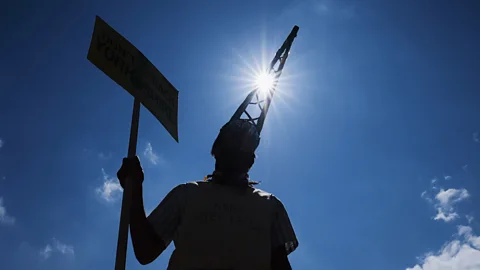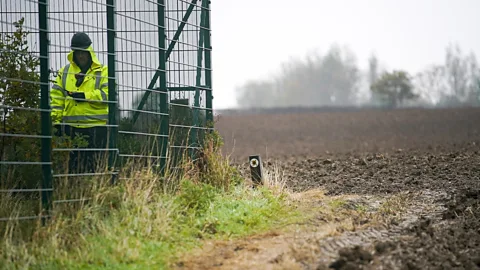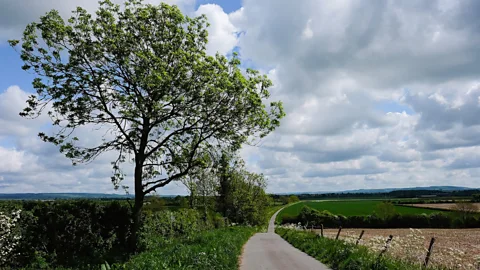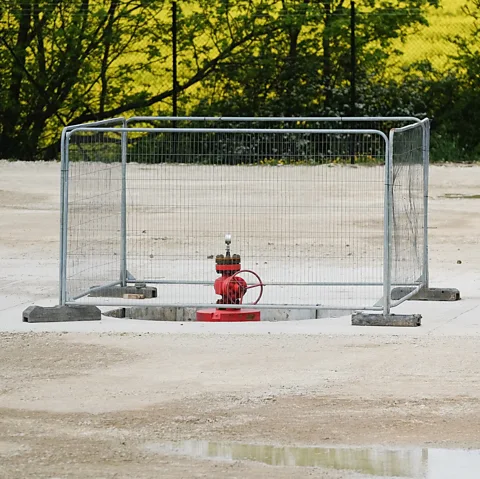The former fracking site now tapped for clean geothermal heat
 Getty Images
Getty ImagesSeveral old fossil fuel wells in the north of England – including one that runs 3km deep – were going to be used for fracking. Instead, they may be a template for the UK's geothermal industry.
As the police moved in, Mike Potter gritted his teeth. It seemed to him that he and his fellow protesters were being "kettled" – surrounded by police and constrained from moving. "No fracking here!", the demonstrators chanted, gripping their colourful placards.
Fracking, the process of injecting fluid deep into subterranean rock to force out natural gas, emerged during the US Civil War in the 1860s and was first used commercially in the late 1940s. By the 1970s, it had arrived in the UK; over the next 30 years, around 200 gas wells were fracked across the country. But, aside from the question of contributing to further carbon emissions, fracking is potentially dangerous, as it can sometimes trigger earthquakes or contaminate groundwater.
In 2016, the prospect of it came to the tiny village of Kirby Misperton in the north of England, close to Potter's home. That year, a local council granted the energy firm Third Energy planning permission to begin fracking at the site.
"I thought, until all these people, governments and companies, can actually prove to me that they can and will do this safely," recalls Potter, "I'm going to be anti-fracking."
It was a risk. He had a government job with security clearance – if police arrested him, it could have been highly damaging to his career. In the end, widespread opposition to fracking led to the UK government banning the practice in England in 2019.
Potter and his fellow protestors were relieved. But questions remained – namely, what was going to happen to the would-be fracking site, a roughly rectangular patch of ground packed with industrial equipment and surrounded by North Yorkshire fields?
For years, deep boreholes had yielded gas here, but that gas is now depleted. (And this explains Third Energy’s previous attempts to repurpose the wells for fracking, to squeeze some more gas out of the site.) Now, the firm, acquired in 2024 by renewables company CeraPhi Energy, says it has a new and very different idea: geothermal energy.
 Getty Images
Getty ImagesAround the world, many different forms of geothermal energy are in use. Iceland, for instance, gains a significant portion of its heating needs from geothermal. Its engineers have long worked on a project to tap into the searing heat of an underground volcano to generate electricity.
But geothermal potential also lies in less geologically active places. And old oil wells, sometimes multiple kilometres deep, can reach underground regions that are naturally warm. The deeper you go, the hotter the rocks tend to be.
In the approach proposed by Third Energy, known as closed-loop geothermal, a sealed, water-filled loop is sunk deep inside former oil or gas wells to absorb the naturally occurring heat at their bases. The warmed water in the loop then returns to the surface. In this way, the heat can be passed to nearby buildings.
Unlike fracking, there is no forcing of fluid into the adjacent rock. "You're not touching the geology at all," says Russell Hoare, managing director at Third Energy. "You're just putting a small tube on the inside of the well."
The deepest well at Kirby Misperton, dubbed KM8, descends for 3km (1.9 miles). In tests, the temperature at the well's base was even hotter than Third Energy expected – around 115C (240F), rather than the anticipated 90C (190F) or so. Early experiments by Third Energy suggested that the system could maintain a steady temperature of around 42C (108F) at the surface. Heat pumps would boost this heat supply further, if necessary, before passing it on to local homes.
"That well, if it was configured properly, could probably provide enough heat for 100 homes," says Hoare.
Hoare also says that Third Energy has a total of 12 wells it could use for geothermal energy in Yorkshire, three of them at Kirby Misperton. "What this gives me is potentially another 25-plus years' life out of those wells," he adds, explaining that the firm is keen to drill additional wells locally to expand their future network of geothermal boreholes, if possible.
 Getty Images
Getty ImagesThe process isn't cheap. Even for a well half the depth of KM8, it could cost up to £1m ($1.3m) to drill and fit it with the water loop equipment. But there's a big potential pay-off, says Hoare: the wells might provide heat for many years, practically without interruption, so long as the resource is maintained by occasionally topping up the underground heat. This could be achieved by periodically sending hot water down the loop within the well to raise the temperature of the geology below.
Former protestors like Potter scrutinised Third Energy's proposals. Many were initially sceptical of the plans. But after witnessing a demonstration of how the system might work, Potter says, "I was absolutely blown away." He now volunteers on behalf of Third Energy and has canvassed local organisations and businesses, from schools to a nearby swimming pool, to find out how much heat energy they need and whether they might be able to make use of a future geothermal supply.
Fellow former protestor and local resident Hazel Winter, a teaching assistant, is also gung-ho for the new idea. "It's all for the good, it's a complete turnaround," adds Winter. "It helps them keep fossil fuels in the ground and it could be the template for a whole new industry."
Potter recalls marvelling at the system – heat drawn out of the ground and yet no disruption to the rock or soil below. "I was looking at this thinking, 'This is just too good to be true – what's the catch?'" he says.
However, there may be one, according to Gioia Falcone, an expert in geothermal energy at the UK's University of Glasgow. In particular, she is highly sceptical of Third Energy's claim that KM8 alone could potentially provide enough heat for 100 British homes. "I doubt very much that even if all 12 boreholes were fitted with this concept that they could be heating 100 homes," she says. She says the claim that KM8 could maintain a tempterature of 42C "contradicts accepted physics of closed-loop deep borehole exchangers, where the initial peak temperature declines significantly with time".
In a conference paper delivered in February 2025, Falcone and colleagues presented an analysis of the KM8 well's potential. They found that KM8 might not stay as hot as hoped. As heat is drawn out of the well, the temperature in the surrounding geology will drop over time, they say. The team calculates that the output temperature may ultimately be limited to 21.8C (71.2F), which would result in only enough heat energy to supply a maximum of 19 homes, if each home uses around 11,200 KWh annually.
Hoare says the paper is "flawed" because Falcone and her colleagues did not have full access to all the data the company has collected about the functioning of the well system – such as the steady state temperature the well has achieved, which is higher than the one calculated by the researchers. Falcone refutes accusations that her team's paper is flawed and says as the company has not made full field test data public, the researchers based their research on an "established and peer-reviewed model" of realistic well operating conditions.
She also doubts that the underground heat could be topped up – a concept known as borehole thermal energy storage – as Hoare suggests, saying her research indicates it is "very inefficient" in single deep borehole heat exchangers.
Hoare also says that the system would perform best with multiple heat pumps at each residential user's property, which the paper does not appear to consider. As a result, he says, the three wells could supply much more energy than the paper's estimate – 6,900,000 kWh over 12 months, or enough for a few hundred homes each requiring 10,000 kWh, allowing for some losses in the distribution of that heat.
Fleur Loveridge at the University of Leeds in the UK, who specialises in underground energy systems, says there are examples of closed-loop borehole heat exchangers that have produced significant amounts of heat. There is one in Germany, for instance, which researchers say has a capacity of 600 kilowatts. This is from a single, roughly 3km-deep borehole, not unlike KM8. That might provide many thousands, or potentially more than a million, kWh of heat energy over a whole year, depending on how the system was managed – which could be enough to heat 100 homes, just as Hoare suggested.
"It certainly sounds ambitious but it doesn't sound impossible," says Loveridge, who praises Third Energy's proposals for Kirby Misperton. "And it's exactly the sort of thing we should be doing."
Roughly a quarter of carbon emissions in the UK comes from the heating of buildings, Loveridge says, and it is particularly difficult to move away from heat sources such as natural gas. The vast majority of domestic heating systems in the UK currently use gas or oil and switching to alternatives can sometimes be costly or impractical for homeowners. Renewables such as geothermal ought to play a "substantive" role in the future, she says.
 Getty Images
Getty ImagesThere are signs that geothermal energy is beginning to gain ground. The British Geological Survey began work on a project in 2024 that will see 28 relatively shallow boreholes, 225m (740ft) deep, drilled near their headquarters in Nottinghamshire – an effort to decarbonise the heating of the organisation's offices.
Elsewhere, the US Geothermal Technologies Office has run an initiative to explore converting old oil wells to geothermal energy sites in states including Utah, Texas and Nevada. The European Union has also funded research in a similar vein.
While Third Energy is focused on deep boreholes, shallow boreholes, less than 500m (1,640ft) in depth, can be useful, too, says Falcone. This is because they can store thermal energy in the summer so that it will be available in the winter when heat is needed. This kind of system could supply a university campus or an urban district, she says.
As for Kirby Misperton, the heavy work required to make Third Energy's proposals a reality has not yet begun. Hoare says the firm received a grant for £40,000 ($50,400) in February, which will help it move further towards launching a large-scale project beyond a mere demonstration.
In the meantime, Potter fizzes with enthusiasm at the potential. "This is our home-produced heat energy," he says, mindful of the high price British homeowners have paid for imported gas and other heating fuels in recent years.
If a geothermal project at Kirby Misperton never gets off the ground, or never lives up to the promises made by Third Energy, Potter says he will be "most disappointed". But if it does work and if the technology could be replicated across the rest of the UK, he adds, "It could be absolutely massive."
*Correction: An earlier version of this article incorrectly stated that the Kirby Misperton wells had yielded oil. This has been corrected to clarify that they were gas only wells.
This article was updated further on 10 March 2023 to include a response from Gioia Falcone to criticism of her research and additional context on deep borehole heat exchangers.
--
For essential climate news and hopeful developments to your inbox, sign up to the Future Earth newsletter, while The Essential List delivers a handpicked selection of features and insights twice a week.
